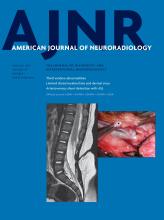Review ArticleHEAD & NECK
Open Access
Spectrum of Third Window Abnormalities: Semicircular Canal Dehiscence and Beyond
M.-L. Ho, G. Moonis, C.F. Halpin and H.D. Curtin
American Journal of Neuroradiology January 2017, 38 (1) 2-9; DOI: https://doi.org/10.3174/ajnr.A4922
M.-L. Ho
aFrom the Department of Radiology (M.-L.H.), Mayo Clinic, Rochester, Minnesota
G. Moonis
bDepartment of Radiology (G.M.), Columbia University, New York, New York
C.F. Halpin
cDepartments of Otolaryngology (C.F.H.)
H.D. Curtin
dRadiology (H.D.C.), Massachusetts Eye and Ear Infirmary, Boston, Massachusetts.

References
- 1.↵
- Minor LB,
- Solomon D,
- Zinreich JS, et al
- 2.↵
- 3.↵
- 4.↵
- 5.↵
- 6.↵
- Chen EY,
- Paladin A,
- Phillips G, et al
- 7.↵
- Loke SC,
- Goh JP
- 8.↵
- 9.↵
- 10.↵
- Yuen HW,
- Boeddinghaus R,
- Eikelboom RH, et al
- 11.↵
- 12.↵
- Koo JW,
- Hong SK,
- Kim DK, et al
- 13.↵
- Krombach GA,
- DiMartino E,
- Schmitz-Rode T, et al
- 14.↵
- 15.↵
- 16.↵
- 17.↵
- Ikeda R,
- Kobayashi T,
- Kawase T, et al
- 18.↵
- 19.↵
- Young RJ,
- Shatzkes DR,
- Babb JS, et al
- 20.↵
- 21.↵
- 22.↵
- Dahiya R,
- Keller JD,
- Litofsky NS, et al
- 23.↵
- 24.↵
- Valvassori G,
- Clemis J
- 25.↵
- Boston M,
- Halsted M,
- Meinzen-Derr J, et al
- 26.↵
- Sennaroglu L,
- Saatci I
- 27.↵
- 28.↵
- 29.↵
- 30.↵
- Friedmann DR,
- Eubig J,
- Winata LS, et al
- 31.↵
- 32.↵
- Kupfer RA,
- Hoesli RC,
- Green GE, et al
- 33.↵
- Friedmann DR,
- Le BT,
- Pramanik BK, et al
- 34.↵
- 35.↵
- Arjmand EM,
- Webber A
- 36.↵
- Merchant SN,
- Nakajima HH,
- Halpin C, et al
- 37.↵
- 38.↵
- 39.↵
- 40.↵
- 41.↵
- Friedman RA,
- Bykhovskaya Y,
- Tu G, et al
- 42.↵
- Huang BY,
- Zdanski C,
- Castillo M
- 43.↵
- 44.↵
- 45.↵
- Talbot JM,
- Wilson DF
- 46.↵
- Kumar G,
- Castillo M,
- Buchman CA
- 47.↵
- Cremers CW,
- Snik AF,
- Huygen PL, et al
- 48.↵
- Snik AF,
- Hombergen GC,
- Mylanus EA, et al
- 49.↵
- 50.↵
- 51.↵
- 52.↵
- Merchant SN,
- Rosowski JJ,
- McKenna MJ
- 53.↵
- 54.↵
In this issue
American Journal of Neuroradiology
Vol. 38, Issue 1
1 Jan 2017
Advertisement
M.-L. Ho, G. Moonis, C.F. Halpin, H.D. Curtin
Spectrum of Third Window Abnormalities: Semicircular Canal Dehiscence and Beyond
American Journal of Neuroradiology Jan 2017, 38 (1) 2-9; DOI: 10.3174/ajnr.A4922
0 Responses
Jump to section
Related Articles
- No related articles found.
Cited By...
- Prevalence of Cochlear-Facial and Other Non-Superior Semicircular Canal Third Window Dehiscence on High-Resolution Temporal Bone CT
- The Forgotten Second Window: A Pictorial Review of Round Window Pathologies
- Carotid-cochlear dehiscence: a dangerous mimicker of inner ear pathologies
- Cavitary Plaques in Otospongiosis: CT Findings and Clinical Implications
This article has been cited by the following articles in journals that are participating in Crossref Cited-by Linking.
- P. Ashley Wackym, Carey D. Balaban, Pengfei Zhang, David A. Siker, Jasdeep S. HundalFrontiers in Neurology 2019 10
- Kimberley S. Noij, Steven D. RauchFrontiers in Neurology 2020 11
- Xiying Guan, Y. Song Cheng, Deepa J. Galaiya, John J. Rosowski, Daniel J. Lee, Hideko Heidi NakajimaScientific Reports 2020 10 1
- P. Puac, A. Rodríguez, H.-C. Lin, V. Onofrj, F.-C. Lin, S.-C. Hung, C. Zamora, M. CastilloAmerican Journal of Neuroradiology 2018 39 6
- Kimberley S. Noij, Kevin Wong, Maria J. Duarte, Salwa Masud, Nicholas A. Dewyer, Barbara S. Herrmann, John J. Guinan, Elliott D. Kozin, David H. Jung, Steven D. Rauch, Daniel J. LeeOtology & Neurotology 2018 39 9
- Pierre Reynard, Samar Idriss, Aicha Ltaief-Boudrigua, Pierre Bertholon, Andreea Pirvan, Eric Truy, Hung Thai-Van, Eugen C. IonescuFrontiers in Neurology 2022 12
- J.C. Benson, F. Diehn, T. Passe, J. Guerin, V.M. Silvera, M.L. Carlson, J. LaneAmerican Journal of Neuroradiology 2020 41 2
- Kimberley S. Noij, Barbara S. Herrmann, John J. Guinan Jr., Steven D. RauchAudiology and Neurotology 2018 23 6
- Joshua A. Lee, Yuan F. Liu, Shaun A. Nguyen, Theodore R. McRackan, Ted A. Meyer, Habib G. RizkOtology & Neurotology 2020 41 4
More in this TOC Section
Similar Articles
Advertisement











